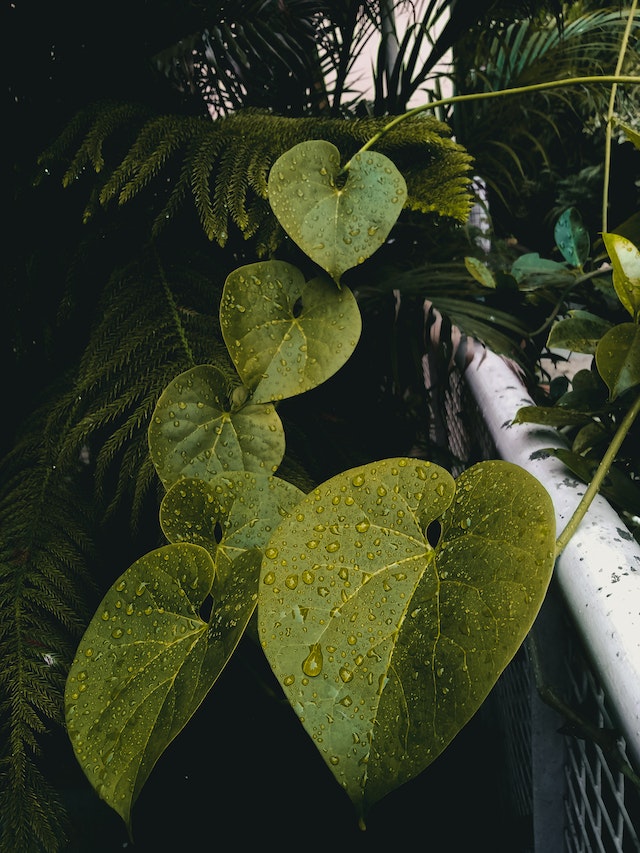HousePlantJoy is supported by our audience. When you purchase through one of our links, we may earn a small affiliate commission. As an Amazon Associate I earn from qualifying purchases. Your cost is not affected.
==================
Here’s a fun fact: the Heart Fern houseplant is a big favorite among indoor plant lovers! Why, you ask? Well, it’s easy on the eyes and easy to care for. You’ll spot these tropical beauties by their heart-shaped leaves. Plus, they grow on dark, almost black stems and can get as tall as 10 inches. They don’t have flowers, but their shiny evergreen leaves are a sight to behold in any home!
Heart Fern Houseplant: A Guide to Care and Maintenance
For the Heart Fern to grow, you need to give it some specific conditions. It likes a cozy temperature between 60 and 85 degrees Fahrenheit. A cool night and a warmer day suit it best. It needs soil that can drain water well, is fertile, and is moist and rich with humus. Plus, Do you want to make your Heart Fern feel more at home? Try keeping a tray filled with gravel under it to up the humidity!
Are you thinking about adding a Heart Fern to your indoor plant gang? Then this article is for you! It’s got all the tips you need to keep your Heart Fern healthy and thriving. From how often to water it to when to give it food and how to replot and help it grow more Heart Ferns, we’ve got you covered!
Heart Fern Houseplant Overview
Heart Fern, also known as Hemionitis arifolia, is a popular houseplant. It is adored for its unique heart-shaped leaves. This fern is native to tropical regions and is known for its compact size and striking black stems. The Heart Fern is an easy plant to care for, making it an excellent choice for beginners.
The Heart Fern typically grows to be between 6 and 8 inches tall, making it an excellent choice for small spaces. Its dark green, heart-shaped fronds are about 2 – 3 inches long and are borne on black stems. The leaves are dimorphic, meaning some are sterile and some are fertile.
One of the standout qualities of the Heart Fern is its love of warmth and high humidity levels. This plant thrives in brightly lit rooms. And you should place it in an area with plenty of indirect sunlight. Keeping the soil moist but not too wet is also essential, as overwatering can lead to root rot.
When it comes to soil requirements, the Heart Fern prefers more acidic soil with a pH range of 5.0-6.5. However, it can survive off a pH balance of 7.0 for some time. You can add Lemon juice to the soil to increase the acidity if necessary.
The Heart Fern is a beautiful, unique houseplant that is easy to care for. With the right amount of light, humidity, and water, this plant can bring a touch of the tropics into any home.
Ideal Growing Conditions
When it comes to Heart Fern Houseplants, the ideal growing conditions are essential. Heart Ferns are native to regions with warm temperatures and high humidity. Replicating these conditions in your home is critical to their success.
-
Light Requirements
Heart Ferns thrive in low to medium light conditions. They love bright, indirect light but can tolerate lower light conditions. Direct sunlight can damage their delicate leaves. So it’s best to keep them away from windows that receive direct sunlight.
-
Temperature Preferences
Heart Ferns prefer warm temperatures. This is between 60°F to 75°F. They are sensitive to cold temperatures. Plus, they can suffer damage if exposed to temperatures below 50°F (10°C). Keep them away from cold drafts from windows or doors. And you should avoid placing them near air conditioning vents or heaters.
-
Humidity Needs
High humidity is crucial for Heart Ferns. They require humidity levels of at least 50%, preferably between 60% and 70%. If the air in your home is dry, consider using a humidifier. You can also place a water tray near the plant to increase humidity. Misting the leaves with water can also help increase humidity levels.
Providing the ideal growing conditions for Heart Ferns will help them thrive. Keep in mind that these plants are sensitive to changes in their environment. So it’s essential to maintain consistent conditions to avoid stress on the plant.
Planting and Repotting Heart Fern Houseplant
Potting Mix
When planting a Heart Fern, it is essential to use a potting mix. It should be well-draining and nutrient-rich. You can make the right mix by combining the same parts of peat moss, perlite, and vermiculite. This mix will provide the necessary drainage, aeration, and moisture retention.
Repotting Procedure
Heart Ferns should be repotted every two years or when the fern has outgrown its current pot. It would be best if you repotted in the spring or summer when the plant is actively growing.
To repot a Heart Fern, follow these steps:
- Select a pot that is one full size more significant than the original pot. The new pot should have drainage holes to prevent water from accumulating in the soil.
- Fill the bottom of the new pot with a layer of fresh potting mix.
- Gently remove the Heart Fern from its current pot and loosen the roots.
- Put the plant in the new pot and fill in around the roots with a good potting mix. Be sure to leave enough space at the top of the pot for watering.
- Water the plant entirely and allow excess water to leave out of the bottom of the pot.
- Put the plant in a bright, indirect light location and maintain the soil moist but not waterlogged.
Heart Fern Houseplant Care and Maintenance
Taking care of your Heart Fern is easy with the proper knowledge. Here are some tips to help you keep your plant healthy and thriving.
-
Watering Schedule
Heart Ferns prefer to be kept consistently moist but not waterlogged. Overwatering can lead the root to rot. While underwatering can make the leaves wilt and turn brown. A good rule of thumb is to water your Heart Fern when the top inch of soil feels dry.
You may need to water your Heart Fern more frequently during the summer months. Be sure to use room-temperature water to avoid shocking the roots.
-
Fertilizer Needs
Heart Ferns do not require a lot of fertilizer. But they can benefit from a monthly dose during the growing season (spring and summer). Choose a balanced, water-soluble fertilizer diluted to half strength to avoid overfertilizing.
-
Pruning Tips
Pruning your Heart Fern is unnecessary, but it can help keep the plant neat and tidy. Use clean, sharp scissors to remove any yellow or brown leaves and any dead or damaged fronds. Be sure to cut as close to the base of the plant as possible without damaging the healthy growth.
It is also a good idea to periodically clean the leaves of your Heart Fern. This is to remove any dust or debris that may have accumulated. Wipe the leaves gently with a damp cloth to keep them looking their best.
Remember to keep your Heart Fern in an area with bright, indirect light and high humidity.
Potential Problems
Heart Ferns are generally easy to care for. But there are a few potential problems that you may encounter when growing these plants.
-
Common Pests
Heart Ferns can be susceptible to pests, such as spider mites and mealybugs. Spider mites are tiny, spider-like pests that can cause damage to the leaves of your fern. In contrast, mealybugs are small, white insects that can leave a sticky residue on the leaves. Here’s how to prevent these pests from infesting your plant. It is important to keep your plant in a clean and well-ventilated area. Also, you should regularly inspect the leaves for signs of infestation.
If you do notice pests on your Heart Fern, there are a few steps you can take to get rid of them. One option is to use an insecticidal soap or oil, which can be used directly to the leaves of your plant. Another option is to use a natural predator, such as ladybugs, to help control the pest population.
-
Disease Issues
Heart Ferns can also be susceptible to diseases, such as fungal infections and root rot. Root rot is an effect of overwatering and can make the roots of your plant to become mushy and brown. To prevent root rot, it is important to avoid overwatering your Heart Fern. This is also to make sure that the soil is well-draining.
Fungal infections can also be a problem for Heart Ferns. This is especially true if the humidity levels are too high. To prevent fungal infections, it is important to maintain proper humidity levels. Also, you should avoid overcrowding your plants.
If you do notice signs of disease in your Heart Fern, it is important to take action right away. This may include removing any infected leaves or stems. Or you can treat the plant with a fungicide or other appropriate treatment.
Propagation Techniques for Heart Fern Houseplant
Propagating from Spores
Propagating Heart Ferns from spores is a time-consuming process. It requires a lot of patience. It is recommended to use sterile equipment. A sterile environment is also important to prevent contamination. Here are the steps to propagate Heart Ferns from spores:
- Collect the spores from mature fronds by placing a paper bag over the frond and shaking it gently.
- Spread the spores evenly on the surface of a sterile growing medium, like a mixture of peat moss and perlite.
- Cover the container with plastic wrap to maintain high humidity levels.
- Put the container in a warm, bright area but out of direct sunlight.
- Maintain the growing medium moist but not waterlogged.
- After several weeks, tiny heart-shaped fronds will appear. Wait until they are big enough to be transplanted. Then you can move them to their permanent location.
Propagating by Division
Propagation by division is a quicker and easier way to propagate Heart Ferns. Here are the steps to propagate Heart Ferns by division:
- Carefully remove the Heart Fern from its container. Separate the root ball into 2 or more sections.
- Make sure each section has several healthy fronds and a good root system.
- Plant each section in a container filled with a well-draining potting mix.
- Water the newly potted sections thoroughly. Place them in a bright, indirect light location.
- Keep the soil moist but not waterlogged.
Wrapping It Up
So, there you have it, folks! The Heart Fern houseplant is your ticket to a greener, more lively indoor space. It’s easy to care for, lovely to look at, and brimming with personality. This little green wonder can shoot up to 10 inches with the proper love and care.
Remember, it adores indirect, dappled light and a humid environment. Keep its soil moist, but be careful not to overdo it. Treat it to a balanced, diluted fertilizer during its growing season. You’ll have a happy, thriving Heart Fern.
Embrace the joy of being a plant parent with the Heart Fern. It’s not just a plant; it’s a quiet companion that adds a calming, soothing vibe to your home. So, ready to welcome this heart-shaped wonder into your home? You’re just a Heart Fern away from turning your indoor space into a tropical paradise. Happy gardening!
FAQs
How do you propagate a Heart Fern?
You can propagate Heart Ferns by splitting one up or using its spores. For splitting, gently take out the Heart Fern from its pot and cut the roots into smaller pieces. Each piece should have some leafy fronds and roots. Put each piece in a new pot with fresh soil. For using spores, wait until you see them under the fronds. Collect them and sprinkle them on top of damp soil. Cover it with plastic to keep it humid. When the spores start to grow, take off the plastic and care for your new Heart Ferns.
Can Heart Fern be grown in a terrarium?
Yes, you can! Heart Ferns love humid spaces, so a closed terrarium is perfect. Just make sure it’s big enough for your Heart Fern to grow.
Why are my Heart Fern leaves curling?
If your Heart Fern’s leaves are curling up, it might not be getting enough water, or it’s in a place that’s not humid enough. Keep its soil nice and moist. You could also use a humidifier or put a tray of water near your Heart Fern to increase humidity.
Is Heart Fern toxic to cats?
Absolutely! Heart Ferns are not harmful to cats or dogs, so they’re safe for pet owners to keep around.
Can Heart Fern be grown indoors or outdoors?
Usually, Heart Ferns are grown indoors. But they can also live outdoors if it’s a shady, humid spot.
What kind of light does Heart Fern need?
Heart Ferns like bright light but not direct sunlight, which can burn their leaves. If there’s not enough light, they won’t grow as fast. Place your Heart Fern near a window with filtered light, or you could use artificial grow lights.
Dive into the Enchanting World of Ferns!
Discover the most fascinating ferns and houseplants, including the unique Heart Fern houseplant! Join us on Facebook, Instagram, and Twitter for beautiful photos, plant care tips, and a community that celebrates the joy of indoor gardening.
Facebook: https://www.facebook.com/houseplantjoyblog
Instagram: http://instagram.com/houseplantjoy20
Twitter: https://twitter.com/HouseplantJoy
Let’s nurture our green spaces together!





